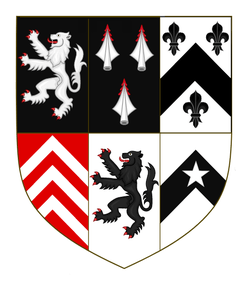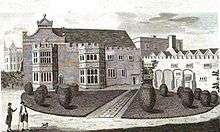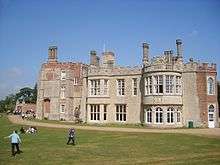Henry Williams (alias Cromwell)
Sir Henry Williams, alias Cromwell (1537[2] – 1604)[3] was a knight of the shire (MP) for Huntingdonshire and a grandfather of Oliver Cromwell.
Sir Henry Williams (alias Cromwell) | |
|---|---|
 Arms of Sir Henry Williams alias Cromwell:– Quarterly of six – 1, Sable, a lion rampant Argent; 2, Sable, three spear-heads Argent, their points imbrued Gules; 3, Argent, a chevron between three fleurs de lys Sable; 4, Gules, three chevronels Argent; 5, Argent, a lion rampant Sable; 6, Argent, on a chevron Sable, a mullet of the field Argent.[1] | |
| Born | Henry Cromwell alias Williams 1537 |
| Died | 6 January 1604 (aged 66–67) |
| Resting place | All Saints' Church, Huntingdon 52.3308°N 0.1850°W |
| Occupation | Courtier |
| Spouse(s) | Joan Warren Susan Weeks |
| Children | Oliver Robert Richard Henry Dorothy Alice Robsert, and others |
| Parent(s) | Sir Richard Williams Frances Murfyn |
His grandfather, Morgan ap William, was the son of a man named William, and also used the name Williams, but his father abandoned the Welsh patronymic system completely and adopted the name of Cromwell, in honour of an uncle Thomas Cromwell, 1st Earl of Essex. The family then consistently used and wrote its name as "Williams, alias Cromwell", well into the 17th century.[4]
Biography
Sir Henry Williams, alias Cromwell, was of Welsh descent, the eldest son and heir of Sir Richard Williams (c. 1510 – 1544) and Frances (c. 1520/1 – c. 1543), daughter of Thomas Murfyn.[5] He was educated at Queens' College, Cambridge.[6]
He was highly esteemed by Queen Elizabeth I, who knighted him in 1564.[3] He was an important enough man, with a large enough house, for the Queen to do him the honour of sleeping at his seat, Hinchingbrooke House, on 18 August 1564, on her return from visiting the University of Cambridge.[7]
Williams, alias Cromwell, was in the House of Commons in 1563, as one of the knights of the shire for Huntingdonshire,[8] and was four times appointed Sheriff of Cambridgeshire and Huntingdonshire, by Elizabeth, viz. in the 7, 13, 22, and 34 years of her reign;[9] and in the 20th, she nominated him a commissioner with others, to inquire concerning the draining of The Fens through Cloughs Cross and so to the sea.[10]


He made Huntingdonshire the entire place of his country residence, living at Ramsey Abbey in the summer, and Hinchingbrooke in the winter; he repaired, if not built, the manor-house at Ramsey, and made it one of his seats. Mark Noble comments that he had heard that the house of Ramsey was only the lodge of that magnificent pile, and converted by Sir Henry into a dwelling-house.[11] Sir Henry also built Hinchingbrooke House adjoining to the nunnery at Hinchingbrooke,[12] and upon the bow windows there he put the arms of his family, with those of several others to whom he was allied.[13]
Sir Henry lived to a good old age, dying 6 January 1604. He was buried in All Saints' Church, Huntingdon, on 7 January.[14] An indication of the funeral pomp used at his interment can be found by the charges of the heralds, which were the same as those incurred at the burial of some of the greatest knights of his day.[15]
Mark Noble stated that Sir William was called, from his liberality, the "golden knight"; and reported that in Ramsey it was said, that whenever Sir Henry came from Hinchingbrooke to that place, he threw considerable sums of money to the poor townsmen.[16] This excellent character is given of him, "he was a worthy gentleman, both in court and country, and universally esteemed";[17] and which his merit justly deserved. By the record of inquisitio post mortem, taken at Ramsey, 2 June, following his death, it appears that he died possessed of these manors in Huntingdonshire, Saltry, Saltry-Moynes, Saltry-Judith, Sawtry-Monastery, all valued at £60 per annum; Warboys and Whistow, with their rectories, and the New-red-deer Park, valued together at £40 per annum; Hinchingbrooke, valued at £10 per annum; Broughton or Broweton, with the rectory, valued at £20 per annum; Berry and Hepmangrove, and the rectory of Berry, valued at £20 per annum; the forests of Waybridge, and Sapley, valued at £6 13s 4d; the farm or grange of Higney, and the messuage called the George, with the land belonging to it, valued at £10 per annum; and the manor of Ramsey, with the farm of Biggin, valued at £100 per annum. all of which were held of king by military service. except the forests of Waybridge and Sapley, together with the farm, or grange of Higney, the tenures of which were unknown.[18]
Family
Sir Henry Williams, alias Cromwell, married twice. His first marriage was to Joan, a daughter of Sir Ralph Warren, twice Lord Mayor of London;[19] she died at Hinchinbrooke and was buried there in All Saints' church in 1584.[20]
Some time after the death of Joan, Sir Henry married a lady of the name of Weeks, who bore for her arms azure a lion rampant checky argent and gules.[21] She was buried at All Saints', Huntingdon, 11 July 1592 but no monument remains of either Sir Henry or of his wives, or indeed any of the name of Cromwell in that place as Huntingdon was devastated during the Civil War and all the monuments and brass plates to the dead were either destroyed or looted.[22] Lady Weeks died of a lingering illness, which in that superstitious age was blamed on witchcraft. On 4 April 1593, in the court presided over by justice Fenner, John Samwell, his wife and daughter were found guilty of causing the death of Joan through witchcraft and executed a few days later (see the Witches of Warboys case).[23]
By the first marriage, Sir Henry had numerous children; by the latter, none. Sir Oliver, the eldest son, gained the bulk of his fortune, to each of the other sons were given estates of about an annual value of £300.[24]
Some of the children of Sir Henry and Joan his first wife were:
- Sir Oliver Cromwell.[25][26]
- Robert Cromwell (c. 1567 - 1617),[27] married Elizabeth Steward (c. 1560 - London, 1654), and had two children:
- Anne Cromwell,[28] married John Sewster, and had Robina Sewster, wife of Sir William Lockhart, of Lee, Scotland, who held the office of Ambassador to France, and had Robina Lockhart (ca. 1662 - Bothwell Castle, Lanarkshire, 20 March 1740/41), married on 19 August 1679 at Lincoln's Inn Chapel, London, to Archibald Douglas, 1st Earl of Forfar (3 May 1653 – 11 December 1712, bur. Bothwell Church)
- Oliver Cromwell (25 April 1599 – 3 September 1658),[29] Lord Protector of England, Scots and Ireland
- Joan Cromwell (d. c. 1641, her will was probated on 14 December 1641), married Sir Francis Barrington, 1st Baronet (c. 1570 - 3 July 1628)[30]
- Mary Cromwell, married Sir William Dunch,[31] of Little Wittenham, Berkshire (d. 22 January 1610/11), and had Edmund Dunch.
- Elizabeth Cromwell (c. 1562 – 1664),[32] married William Hampden (b. Great Hampden, Buckinghamshire, 5 November 1570), son of Griffith Hampden and Anne Cave, and had John Hampden
Notes
- Siddons 2 1993, pp. 602–603.
- Fitzgerald 2020.
- Fuidge 1981.
- Noble 1787, pp. 11–13 explains that the reason for Sir Richard Williams, the great grandfather of Oliver Cromwell, changing his name, from Williams to Cromwell. "Henry VIII strongly recommended it to the Welsh (whom he incorporated with the English) to adopt the English practice in taking family names, instead of their manner of adding their father's, and perhaps grandfather's name to their own Christian one with nap or ap, as Morgan ap William, or Rich, ap Morgan ap William; i.e. Rich, the son of Morgan the son of Will, and the king was the more anxious as it was found so inconvenient in identifying persons in judicial matters. For these reasons, the Welsh, about this time, dropped the ap in many of their names; or, if it could be done with convenience as to pronunciation, left out the a, and joined the p to their father's Christian name (Camden's remains; from which it appears that many Christian names were appropriated to families; for the reasons above "we have the Williams's, Lewis's, Morgans, &c. &c. without number, and, by joining the p, the Pritchards, Powels, Parrys, i. e. ap Richard, ap Howell, ap Harry, &c. &c.). Thus Mr. Morgan ap William, Sir Richard's father, seems, from the pedigree, to have taken the family name of Williams; but, as the surname of Williams was of so late standing, his majesty recommended it to Sir Richard, to use that of Cromwell, in honour of his uncle Thomas Cromwell, 1st Earl of Essex, whose present greatness entirely obliterated his former meanness (Various lives of Oliver, lord protector, &c. as also miss Cromwell's pedigree); and it is observable, that Sir Richard's brothers also changed their name to Cromwell (Will of Sir Richard Williams, alias Cromwell, prerogative-office, London, Allan 20. Pedigree of the Williams's, alias Cromwells, Harl. M.S.S. vol. 1174, and Harl. M.S.S. vol. 4135). Thus did the Williams's take, or super-add the surname of Cromwell to that of Williams; and, in almost all their deeds and wills, they constantly wrote themselves Williams, alias Cromwell, down to the seventeenth century. Though the cause of this change is well known, the time is not: many writers pretend the name of Cromwell was not taken up until the time that Sir Richard, was knighted during a tournament; but this is certainly erroneous, as there are grants of ecclesiastical lands patted to him by his names of Williams, alias Cromwell, as early as 1538: these authors are equally mistaken in supposing that the king never knew Sir Richard until the tournament, which cannot be; because those very grants patted some time before these martial games. With the name of Cromwell, Sir Richard assumed the arms of that family; but Sir Henry, his son, and his descendants, retook the proper arms of the Williams's, and never used any other (if the augmentation of the crest is excepted)".
- Fitzgerald 2019.
- "Cromwell, Henry (CRML540H)". A Cambridge Alumni Database. University of Cambridge.
- Noble 1787, p. 21, Cites Peck's desiderata curiosa.
- Noble 1787, p. 21, Cites: Journals of the house of commons.
- Noble 1787, p. 21, Cites: Fuller's worthies, and nom. vicecom. Harl, coll.no. 259.
- Noble 1787, p. 21, Cites: Dugdale's history of the Fens.
- Noble 1787, p. 21
- "The nuns apartments, or cells, at Hinchinbrook, are now entire, and are used as lodging-rooms for the menial servants; their common room was what is now the kitchen; the church is destroyed, except some trifling ling remains, now part of one of the walls of the house, and seem to have been the corner of the tower; near this place in lowering the flooring, a few years ago, one or more coffins of stone were found." (Noble 1787, p. 21 writing in 1787)
- Noble 1787, p. 22, Cites: Vide the engravings of the arms at Hinchinbrook.
- Noble 1787, p. 22, States: "The inquisitio post mortem gives his death 6 Jan., but as he was buried in a magnificent manner, he could not, we may suppose, be buried the next day. Visit. of Huntingdonfhire, in 1613, says Sir Henry was buried, 24 Jan.."
- Noble 1787, p. 22, Cites: Vide letter F in the proofs and illust.
- Noble 1787, p. 22, States: Communicated by the rev. Tho. Whifton, of Ramfey.
- Noble 1787, p. 22, Cites: Banks's and other lives of the Lord Protector Oliver.
- Noble 1787, p. 23 Cites: T. Cole coll. ex. Recor. Cur. Wardor. Harl. M.S.S. Vol I.
- Noble 1787, p. 23
- Noble 1787, pp. 22,23
- Noble 1787, p. 23 Cites: Visitation of Huntingdonshire in 1613. Harl. M.S.S. vol. 1179.
- Noble 1787, p. 23, notes that Huntingdon was once very large, but was depopulated by the plague. So late as the reign of King Charles I there were four churches in it, but in the devastations owing to the war in the latter part of that monarch's life, this town was severely handled. St. John's church was entirely destroyed, and another church has only the tower remaining; all the monuments and brass plates, before that time, in the other two were destroyed; so that no information respecting the Cromwell family is to be collected from monumental inscriptions in Huntingdon. The outrages Huntingdon felt during the civil war, her townsmen lay to the account of Cromwell; bur they suffered much more from the royal arms, than they did from those of the Parliament, as both Whitlock, in his memorial, and the author of the memoirs of a cavalier, relate.
- Noble 1787, p. 25
- Noble 1787, p. 27 States that in the Life of O. Cromwell, oct. Lond. 1755, 6th ed. says, Mr. Rob. Cromwell, Sir Henry's 2nd son, had an estate of about £300 per ann. so we may presume the other younger sons had estates of about that value.
- Noble 1787, p. 27.
- Lundy 2010 cites: Rosie Davis, "re: Burrard Family," e-mail message to Darryl Lundy, 16 September 2004 – 12 June 2005.
- Lundy 2010 cites: Cokayne et al. 2000, p. 555
- Lundy 2010b cites: Mosley 1999, p. 1282
- Lundy 2010b cites: Mosley 1999, p. 1282 and Cokayne et al. 2000, p. 555
- Cokayne 1900, p. 28.
- Cokayne 1912, p. 436.
- Lundy 2010 cites: Tim Boyle "re: Boyle Family," e-mail message to Darryl Roger Lundy, 16 September 2006.
References
- Cokayne, George Edward, ed. (1900). Complete Baronetage 1611–1625. 1. Exeter: William Pollard and Co. p. 28.CS1 maint: ref=harv (link)
- Cokayne, George Edward, ed. (1912). Complete peerage of England, Scotland, Ireland, Great Britain and the United Kingdom, extant, extinct or dormant (Bass to Canning). 2. London: The St. Catherine Press, ltd. p. 436.CS1 maint: ref=harv (link)
- Fitzgerald, Teri (18 August 2019). "All that Glitters: Hans Holbein's Lady of the Cromwell Family". queenanneboleyn.com. Retrieved 19 October 2019.
- Fitzgerald, Teri (5 March 2020). "Sir Richard Cromwell: A King's Diamond". queenanneboleyn.com. Retrieved 6 March 2020.
- Fuidge, N.M. (1981). "Cromwell, alias Williams, Henry (c.1537-1604), of Hinchingbrooke and Ramsey Abbey, Hunts.". In Hasler, P.W. (ed.). The History of Parliament: the House of Commons 1558-1603,. Boydell and Brewer.
- Lundy, Darryl (18 May 2010). "#131119: Sir Henry Cromwell". thepeerage.com. Retrieved 2 November 2010.CS1 maint: ref=harv (link) This source cites:
- Boyle, Tim. "re: Boyle Family," e-mail message to Darryl Roger Lundy, 16 September 2006.
- Cokayne, G.E.; Gibbs, Vicary; Doubleday, H.A.; White, Geoffrey H.; Warrand, Duncan; de Walden, Howard (2000). The Complete Peerage of England, Scotland, Ireland, Great Britain and the United Kingdom, Extant, Extinct or Dormant, new ed., 13 volumes in 14 (1910-1959). 3 (reprint in 6 volumes ed.). Gloucester, U.K.: Alan Sutton Publishing. p. 555.CS1 maint: ref=harv (link)
- Davis, Rosie. "re: Burrard Family," e-mail message to Darryl Lundy, 16 September 2004 – 12 June 2005.
- Lundy, Darryl (18 May 2010b). "#i109661: Robert Cromwell". thepeerage.com. Retrieved 2 November 2010.CS1 maint: ref=harv (link) This source cites:
- Cokayne, G.E.; Gibbs, Vicary; Doubleday, H.A.; White, Geoffrey H.; Warrand, Duncan; de Walden, Howard (2000). The Complete Peerage of England, Scotland, Ireland, Great Britain and the United Kingdom, Extant, Extinct or Dormant, new ed., 13 volumes in 14 (1910-1959). 3 (reprint in 6 volumes ed.). Gloucester, U.K.: Alan Sutton Publishing. p. 555.CS1 maint: ref=harv (link)
- Mosley, Charles, ed. (1999). Burke's Peerage and Baronetage. 1 (106th, 2 volumes ed.). Crans, Switzerland: Burke's Peerage (Genealogical Books) Ltd. p. 1282.CS1 maint: ref=harv (link)
- Metcalfe, Walter C. (1885). A Book of Knights Banneret, Knights of the Bath, and Knights Bachelor. London: Mitchell and Hughes.
- Siddons, Michael Powell (1993). The development of Welsh heraldry. 2. Aberystwyth: National Library of Wales.
- Attribution

Further reading
- Cokayne, George Edward, ed. (1913). Complete peerage of England, Scotland, Ireland, Great Britain and the United Kingdom, extant, extinct or dormant (Canonteign to Cutts). 3. London: The St. Catherine Press, ltd. p. 555.
External links
| Wikimedia Commons has media related to Henry Williams (alias Cromwell). |
- CROMWELL, alias WILLIAMS, Henry (c.1537-1604), of Hinchingbrooke and Ramsey Abbey, Hunts. in The History of Parliament: the House of Commons 1558-1603, ed. P.W. Hasler, 1981.
- Teri Fitzgerald, Sir Richard Cromwell: A King’s Diamond
- The Cromwell Museum, Huntingdon